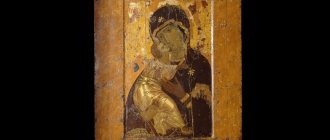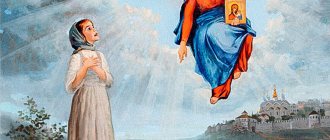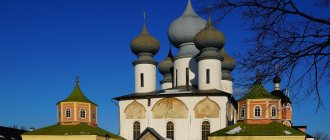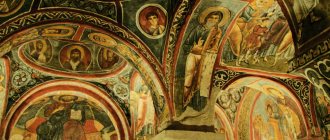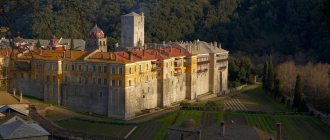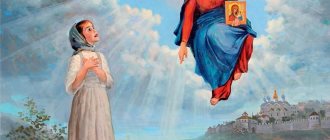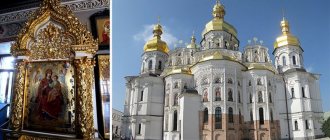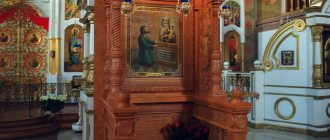The image of the Vladimir Mother of God is one of the most ancient and revered in Russia. The Vladimir Icon of the Mother of God is considered the patroness of the Russian people and Russia itself. The memory of the Presentation of the Vladimir Icon of the Mother of God is celebrated 3 times a year: June 3 (May 21, old style), July 6 (June 23, old style) and September 8 (August 26, old style).
Vladimir Icon of the Mother of God. Holiday event
According to legend, the Vladimir Icon of the Mother of God was painted by St. by the Apostle Luke on a board from the table on which the Holy Family ate in the house of St. St. Joseph - betrothed to the Blessed Virgin Mary. Until 450, this image of the Lady remained in Jerusalem, and then was transferred to Constantinople. In the first half of the 12th century, Patriarch Luka Chrysover of Constantinople sent the icon (together with another image of the Mother of God, known as the “ Pirogoshchaya ”) as a gift to Grand Duke Yuri Vladimirovich Dolgoruky, who placed the image in the Vyshgorod nunnery near Kiev, in an area that once belonged to the great holy Equal-to-the-Apostles Princess Olga. In 1155, Vyshgorod became the inheritance of Prince Andrei, the son of Yuri Dolgoruky.
Having decided to move to his native Suzdal land, Prince Andrei, without his father’s knowledge, took the icon with him. On the way, he constantly served prayers before her. The residents of Vladimir-on-Klyazma greeted their prince with zeal and joy; From there the prince went further to the city of Rostov. However, having driven no more than ten miles from Vladimir, the horses stood on the banks of the Klyazma and, despite urging, did not want to go further. They harnessed the fresh ones, but even those did not go. Struck, Prince Andrei fell in front of the icon and began to pray tearfully. And then the Mother of God appeared to him with a scroll in her hand and commanded him to leave Her image in the city of Vladimir, and on the site of this appearance to build a monastery in honor of Her Nativity. The prince placed the icon in Vladimir, and from that time - from 1160 - it received the name Vladimir.
In 1164, this icon accompanied Prince Andrei Bogolyubsky on a campaign against the Volga Bulgars. Before the battle, the prince confessed and took communion; Having fallen before the image of the Mother of God, he exclaimed:
Everyone trust in Thee, the Lady, and will not perish!
The entire army, following their prince, kissed the miraculous woman with tears and, calling for the intercession of the Most Pure One, moved into battle. The wicked were defeated.
The icon is glorified for granting many victories to the Russian people over the enemies of our Fatherland, mainly the Tatars. Moscow owes its blessings for deliverance from the raids of Khan Edigei in 1408, the Nogai prince Mazovsha in 1451, and his father, Khan Sedi-Akhmet, in 1459.
Interesting fact
In 1989, the famous Hollywood actor Mel Gibson created a movie, and for the logo he chose part of the image of the icon of the Vladimir Mother of God - the eye of the Virgin and her nose.
Many believers are familiar with this logo. He appears before the start of the film "The Passion of the Christ". So, legends and traditions that have survived to modern times, and art historians differ on when and how the icon of the Mother of God appeared and why it received the name “Vladimir”. But people are inclined to believe the chronicles and those legends about the icon that were passed down from generation to generation. Since ancient times, the Vladimir Icon of the Mother of God has helped the Russian people win wars without resorting to battles. This was especially true of the raids of the Tatar-Mongol yoke. Miraculously, the Mother of God helps people even now, those who with a pure heart and without malicious intent pray to God before her, asking for their needs. Events associated with this icon are celebrated three times a year, which indicates that it greatly influenced the destinies of people and brought a lot of benefit to the people. Looking at the Virgin Mary and Little Jesus Christ, believers understand that the Mother voluntarily and lovingly gives her child as a sacrifice for the sins of all humanity. She knew the divinity of her child and believed that He would fulfill the destiny given to Him by God the Father.
Troparion, kontakion and canon of the Vladimir Icon of the Virgin Mary
Troparion, tone 4.
Today the most glorious city of Moscow shines brightly, as the dawn of the sun has received Your miraculous icon to the Lady. We are now flowing to her, and praying to You, we cry out to You, O Most Wonderful Lady Theotokos, praying from You to the incarnate Christ our God, may He deliver this city, and all Christian cities and countries unharmed, from all the slander of the enemy, and save our soul, as He is merciful .
Kontakion, tone 8.
To the Chosen Voivode and Intercessor, the Virgin and Mother of God, established in a clear conscience by the faith of the Russian people, who has irrevocable hope as a harbinger, and especially to Her miracle-working and Most Pure Image, and crying out to Her, Rejoice, Unmarried Bride.
Library of the Russian Faith Canon of the Vladimir Icon of the Blessed Virgin Mary →
Read online
Symbolism of color
Color symbolism was developed later, basic symbolic colors such as gold, white, purple, blue were established in iconography and taken from the Bible. Even in the most ancient icons, these colors appear and carry a certain meaning.
Purple in symbolism
Of great importance in the icons of the Mother of God is the color purple, or, in the modern sense, dark brown, like a mixture of blue and red, the color of dried blood. In Latin it sounds like “purple”, in Greek “porphyra”, in Russian “crimson”. This is the color used to paint the robe of the Virgin Mary.
In the world, this is a royal color - a symbol of high royalty. This is especially expressed in the attire of the Jewish kings in ancient Byzantium, then in Rome the emperors wore purple robes.
It would be correct to say that the king or queen had to obtain the right to wear purple; other people could wear any color except this.
The Virgin Mary by birth was not a royal person, but because she gave birth to the Son of God on Earth, she forever became the Queen of Heaven, and on icons the Mother of God is always depicted in purple.
This is one of the meanings of the color purple; the bloody color also symbolizes birth, incarnation in the human body and death. The Most Holy Theotokos, according to this symbol, is called Chervlenitsa, that is, the parent who painted the King of Powers and Light with her feat, gave birth to the son of God on Earth, giving him her flesh and blood, becoming the material for the Savior, God incarnate.
And in this contrast of gold and purple we see the importance and significance of the birth of Christ and their relationship. The Son of God comes into the arms of the Most Holy Theotokos from this golden space of Light and finds himself in Her arms.
Icon painters deliberately do not depict Jesus in material clothing in order to preserve his heavenly divine image. White color with a grid of golden assist - rays of Light, brings to people the material and divine perception of the incarnate God.
The human and the divine in Christ are present unfused and inseparable.
Vladimir Icon of the Mother of God. History of veneration
The memory of the Presentation of the Vladimir Icon of the Mother of God is celebrated three times a year: June 3 (May 21, old style), July 6 (June 23, old style) and September 8 (August 26, old style).
The celebration of June 3 was established in 1521 in honor of the deliverance of Moscow from the invasion of the Kazan Khan Makhmet-Girey . Metropolitan Varlaam and all the people fervently prayed before the face of the Vladimir Icon of the Mother of God. Grand Duke Vasily Ivanovich barely had time to gather an army to meet the Tatars at the far frontier, on the Oka River. Holding back their onslaught, he slowly retreated to Moscow.
On the very night of the siege, the nun of the Kremlin Ascension Monastery saw saints emerging through the locked doors of the Assumption Cathedral, carrying in their hands the miraculous Vladimir Icon. These were the holy metropolitans of Moscow Peter and Alexy, who lived two centuries earlier. And the nun also saw how the Venerable Varlaam of Khutyn and Sergius of Radonezh met the procession of saints at the Spasskaya Tower - and fell prostrate before the icon, praying to the Most Pure One not to leave the Assumption Cathedral and the people of Moscow. And then the Intercessor returned through the locked doors. The nun hastened to tell the townspeople about the vision. Muscovites gathered in the temple and began to pray fervently. And the Tatars again saw a vision of “a great army, shining with armor,” and they fled from the walls of the city.
On July 6, the celebration of the Presentation of the miraculous icon of the Most Holy Theotokos of Vladimir was established in memory of the deliverance of Russia from the Mongol-Tatar yoke in 1480 . This significant event in Russian history is described in detail in the chronicle “ The Tale of the Standing on the Ugra ”. After the victory, the Russian state became sovereign not only in fact, but also formally.
In the spring of 1480, Khan of the Great Horde Akhmat went on a campaign against Rus', which had refused to pay tribute to the Tatars since 1476. Moving forward to Moscow, he reached the mouth of the Ugra River, the left tributary of the Oka, where he was stopped by the Russian army. If the Horde cavalry had managed to cross the river, then after three or four crossings Akhmat’s army could have approached the capital. Russian military leaders blocked all fords and river crossings for the Tatars. For several days there were battles for crossing the Ugra, and when all attacks were repulsed, the “stand on the Ugra” began. This standing, according to the chronicler, was peaceful and quiet. At this time, all of Rus' offered prayers to the Most Holy Theotokos, especially fervently in front of Her Vladimir Icon, which had already demonstrated its miraculous help more than once, saving the country from destruction.
In November, Prince Ivan III ordered the withdrawal of Russian forces from Ugra to Borovsk, and Khan Akhmat, deciding that the coast was being given up to him for a decisive battle, suddenly became very frightened and began a quick retreat. Only small Russian forces were sent in pursuit of the retreating Horde, but they finally expelled the enemy from their native land. In memory of this event, a religious procession from the Assumption Cathedral to the Sretensky Monastery began to be held annually in Moscow. And the Ugra River has since been known as the Belt of the Virgin Mary.
On September 8, the holiday was established “ for the sake of deliverance from the invasion of the godless Hagarians, the vile king Temir-Askak .” In 1395, Tamerlane with hordes of Tatars approached Moscow. The Christian people had only hope for God's help. And then the Grand Duke of Moscow Vasily Dmitrievich ordered to bring the icon from Vladimir to Moscow. The Lady’s journey from the banks of the Klyazma lasted ten days. On both sides of the road, kneeling people stood and, stretching out their hands to the icon, cried out: “Mother of God, save the Russian land!” A solemn meeting awaited the Vladimir Icon in the white stone: a religious procession with all the city clergy, the family of the Grand Duke, boyars and ordinary Muscovites came to the city walls on Kuchkovo Field, met and escorted the miraculous one to the Assumption Cathedral of the Kremlin. It was August 26 (Old style). “The whole city came out in front of the icon to meet it,” the chronicler testifies. Metropolitan, Grand Duke, “husbands and wives, young men and virgins, children and babies, orphans and widows, from young to old, with crosses and icons, with psalms and spiritual songs, moreover, saying everything with tears, who cannot find a person, not crying with silent sighs and sobs.”
And the Mother of God heeded the prayer of those who trusted in Her. At the very hour of the meeting of the miraculous on the banks of the Moscow River, Tamerlane had a sleepy vision in his tent: saints with golden staves were descending from a high mountain, and above them in indescribable grandeur, in the radiance of bright rays, the Radiant Woman was hovering; countless hosts of Angels with fiery swords surrounded Her. Tamerlane woke up, trembling with horror. The sages, elders and Tatar fortune-tellers he convened explained that the Woman he had seen in a dream was the Intercessor of the Orthodox, the Mother of God, and that Her power was invincible. And then the Iron Lame ordered his hordes to turn back.
Prayers to the icon
There are a lot of canonical prayers addressing the Most Holy Theotokos. Let's list some of them.
Full text of the canonical prayer
Second prayer O All-Merciful Lady Theotokos, Heavenly Queen, All-Powerful Intercessor, our shameless Hope! We thank You for all the good deeds that have been revealed to the Russian people from You, from ancient times to the present day from Your miraculous icon. And now, Blessing the Lady, look upon us, Thy sinful and unworthy servants, show us Thy mercy and pray to Thy Son, Christ our God, that we may be delivered from all evil and that every city and village, and our whole country, may be saved from famine and destruction. , coward, flood, fire, sword, invasion of foreigners and internecine warfare. Ask Orthodox Christians for a prosperous and peaceful life, health, long life, good haste and salvation in everything. Preserve and make wise the shepherds of the Church, who are worthy to shepherd the flock of Christ and have the right to rule the word of truth; Strengthen the Christ-loving All-Russian army, give the spirit of advice and reason to the military commander, the mayor and everyone in power, bestow Your holy blessing on all Orthodox Christians who worship Ti and pray before Your celibate icon. Be our Intercessor and Intercessor before the throne of the Most High, where you stand. To whom shall we resort if not to You, Lady? To whom shall we bring tears and sighs, if not to You, Most Holy Theotokos? There are no imams of any other help, no imams of any other hope, except for You, Heavenly Queen. We flow under Your protection, through Your prayers grant us peace, health, fruitfulness of the earth, goodness of the air, deliver us from all troubles and sorrows, from all ailments and illnesses, from sudden death and from all the bitterness of enemies visible and invisible. Enlighten and teach us, O All-Merciful Intercessor, how to sinlessly pass the path of this earthly life; You weigh our weaknesses, you weigh our sins, but you also weigh our faith and see our hope; Grant us correction of our sinful lives and soften our evil hearts. Strengthen the right faith in us, put into our hearts the spirit of the fear of God, the spirit of piety, the spirit of humility, patience and love, success in good deeds; Deliver us from temptations, from destructive, soul-harming teachings, from unbelief, corruption and eternal destruction. We therefore ask You, Most Pure Lady, and falling before Your holy icon, we pray, have mercy on us and have mercy on us, and on the terrible day of judgment, through Your intercession and intercession, make us worthy to stand at the right hand of Your Son, Christ our God, to Him belongs all glory, honor and worship, with His Beginning Father, and His Most Holy and Good and Consubstantial Spirit, now and ever and unto ages of ages. Amen.
Prayer for choosing a path and help in difficult times
Offering to my queen, my hope to the Mother of God, a refuge for the orphans and the strange, the sorrowful, the joyful, the offended patroness! See my misfortune, see my sorrow, help me as I am weak, feed me as I am strange. Weigh my offense, resolve it, as you will: for I have no other help except You, no other intercessor, no good comforter, except You, O Mother of God, for you will preserve me and cover me forever and ever. Amen.
Prayer for the health and well-being of household members
O Most Holy Lady Lady Theotokos! Accept our unworthy prayer, and save us from the slander of evil people and from sudden death, and grant us repentance before the end. Have mercy on our prayer, and grant joy instead of sorrow. And deliver us, Lady, from all misfortune and adversity, sorrow and illness and all evil. And we, Thy sinful servants, are made worthy to be at the right hand at the second coming of Thy Son, Christ our God, and heirs of the existence of the Kingdom of Heaven and eternal life with all the saints throughout the endless ages of ages. Amen.
It is not necessary to learn prayers by heart: they can also be read from sight. The main thing is to pray sincerely and with true faith!
Gold pendant “Vladimir Icon of the Mother of God” (go to SUNLIGHT catalogue)
20.10.21
Image of the Vladimir Icon of the Mother of God. Iconography
Iconographically, the Vladimir Icon belongs to the Eleus (Tenderness) . The Baby pressed his cheek to the Mother's cheek. The icon conveys the tender communication between Mother and Child. Mary foresees the suffering of the Son in His earthly journey. Similar iconography was known in early Christian art, but it became especially widespread in the 11th century. A distinctive feature of the Vladimir Icon from other icons of the Tenderness type: the left leg of the Infant Christ is bent in such a way that the sole of the foot—the “heel”—is visible.
Our Lady of Vladimir. Rublev Andrey (?) Late XIV - early XV centuries. Vladimir-Suzdal Historical, Art and Architectural Museum-Reserve, Vladimir “Vladimirskaya” with the hallmarks of icons of the Mother of God, Mother Do Not Weep for Me, Quench My Sorrows and the Annunciation. Pskov school, approx. 1500
Meeting of the Vladimir Icon. 15th century
According to art historians, the Vladimir Icon of the Virgin Mary was painted in the 12th century, apparently in Constantinople. The original size of the icon was 78x55 cm. Later the margins were increased. On the back of the icon there is an image of Etymasia (which means “prepared throne”) and the instruments of the passions, which presumably dates back to the beginning of the 15th century (the time of the second repair of the icon). There are versions that the icon was double-sided from the very beginning: this is evidenced by the identical shapes of the ark and the husks of both sides.
Image of the Mother of God of Vladimir. Constantinople. First third of the 12th century
Throughout its history, the icon was recorded at least four times: in the first half of the 13th century, at the beginning of the 15th century, in 1514, during alterations in the Assumption Cathedral of the Moscow Kremlin, before the coronation of Nicholas II in 1895-1896 by restorers O.S. Chirikov and M.D. Dikarev . In addition, minor repairs were carried out in 1567 (at the Chudov Monastery by Metropolitan Athanasius), in the 18th and 19th centuries. In fact, only fragments of the Constantinople image have survived. The most ancient painting of the 12th century includes the faces of the Mother and the Child, part of the blue cap and maforium border with a gold assist, as well as part of the ocher chiton of the Child with a gold assist with sleeves to the elbow and the transparent edge of the shirt visible from under it, the left hand and part of the right the hands of the Child, as well as the remains of a golden background. A diagram-cartogram of fragments of different layers of painting of the icon “ Our Lady of Vladimir ” allows you to see these records.
Our Lady of Vladimir. First quarter of the 15th century. Assumption Cathedral of the Moscow Kremlin, Moscow
The icon previously stood in the Assumption Cathedral of the Moscow Kremlin on the left side of the royal doors of the iconostasis. A Greek-made chasuble on an icon made of pure gold with precious stones was estimated at about 200,000 gold rubles (now in the Armory Chamber). In 1918, the Assumption Cathedral in the Kremlin was closed, the icon was removed from the cathedral for restoration, and in 1926 it was transferred to the State Historical Museum. In 1930 it was transferred to the State Tretyakov Gallery. Since September 1999, the icon has been in the Church-Museum of St. Nicholas in Tolmachi at the Tretyakov Gallery.
Symbolism of the icon and its style
Theologians interpret the symbolism of the icon as meaning that the Virgin Mary intends her baby Jesus to be a sacrifice for the sins of all mankind. They came to this conclusion because on the reverse side of the icon there are symbols of the suffering of Christ (a cane with a sponge, a spear and a cross). The tenderness and affection that is depicted on the icon “speaks” that the Mother loves her Son very much, but gives him up to desecration and death in order for Him to save humanity from sin and hell, completely voluntarily. Because he understands that the world will no longer have another Savior.
The icon was painted during the period of Byzantine art and refers to the dematerialization of painting, which is characterized by blurred and barely visible outlines, there are no clear lines, but there are details. The clothes of the Mother of God and the Child lay on the image in a certain pattern. The impression of a miraculous work is created by weak lines, which was the main means of expressing painting of that time. This is a canonical sample without special graphics.
Temples of the Vladimir Icon of the Mother of God in Rus'
In 1397, Prince Vasily I founded the Sretensky Monastery on Kuchkovo Field in Moscow in memory of the miraculous event reported by chronicle sources. On August 26, 1395, a religious procession led by Saint Cyprian met the miraculous image of the Vladimir Icon of the Mother of God, brought from Vladimir-on-Klyazma. A day later, Timur-Tamerlane turned south. The defenseless Moscow lying before him was saved. In memory of deliverance from the invasion, the Sretensky Monastery was founded. Every year on August 26, the Vladimir Icon was transferred in a procession from the Assumption Cathedral to the place where the miraculous image of the Mother of God was met. The Feast of the Presentation of the Vladimir Icon was the main local holiday in Moscow. To date, the original buildings of the monastery have not survived. The five-domed cathedral church of the monastery (the only one to survive in the 20th century) was built in 1679 at the expense of Tsar Feodor Alekseevich. In 2008, a gallery with a belfry was added to the cathedral.
Sretensky Monastery in Moscow
A church in Vologda was consecrated in honor of the Vladimir Icon of the Mother of God. The exact date of its foundation is not known, but the inscription on the temple icon of the Vladimir Mother of God indicates that in 1549 a wooden church already existed. In 1759 (according to the church charter), instead of the previous church, a new stone Vladimir Church (cold) was built in a new place. Closed in 1929, the church building was restored in the 1970s.
Church of the Presentation of the Vladimir Icon of the Mother of God (cold). Vologda
Twice Saved
Russian princes and tsars prayed in front of this icon when going on campaigns. When electing Moscow metropolitans, and subsequently patriarchs, the lots of those elected were placed in the shroud of this icon. Before her, the noblest people of Moscow took the oath of allegiance to their sovereigns.
In 1547 there was a strong fire in the Moscow Kremlin. They were going to take out the miraculous icon: several of the strongest and bravest men were sent to remove it and take it to a safe place outside the Kremlin. But no force could move the shrine from its place. According to eyewitnesses, at that moment a vision of a “luminous Woman overshadowing the temple” appeared in the sky above the Assumption Cathedral... Soon the fire subsided. Among the ashes stood the Assumption Cathedral, untouched by fire.
Since then, the Holy Vladimir Icon of the Mother of God has always been in the Kremlin Assumption Cathedral. Before her, kings were anointed to the kingdom and high priests were elected. In Soviet times, the icon was placed in the Tretyakov Gallery; fortunately, it was not lost like many Orthodox shrines during the years of persecution of the church.
Now the Vladimir Icon of the Mother of God is kept in the St. Nicholas Church in Tolmachi. Photo: roslavl-dhsh.ru
In September 1999, one of the main Orthodox shrines in Russia was transferred to the Church of St. Nicholas at the Tretyakov Gallery (metro Tretyakovskaya, M. Tolmachevsky lane, 9). There it is kept to this day under bulletproof glass, and special devices maintain a special temperature and humidity regime...
Old Believer churches of the Vladimir Icon of the Mother of God
Several Old Believer churches were consecrated in honor of the Vladimir Icon of the Mother of God. In Moscow there is a temple in the name of the Vladimir Icon of the Most Holy Theotokos of the Ostozhensk community. The church was built in 1907–1911. initially in honor of the Intercession of the Most Holy Theotokos, but due to the large number of Intercession churches in the Old Believers, this temple was later reconsecrated. Also in the church there is a chapel in the name of the Nativity of St. Nicholas, the throne is celebrated on August 11.
Church of the Russian Orthodox Church in the name of the Vladimir Icon of the Blessed Virgin Mary. Moscow
In the Russian Orthodox Church, in honor of the Vladimir Icon of the Most Holy Theotokos, a temple in the village was consecrated. Tonkino, Nizhny Novgorod region, chapel in the village. For the Motherland of the Krasnodar Territory and the house church in Krasnoyarsk.
Temple of the Vladimir Icon of the Blessed Virgin Mary in the village. Tonkino, Nizhny Novgorod region
Chapel of the Vladimir Icon of the Blessed Virgin Mary in the village. For the Motherland
In the RDC, in honor of the Vladimir Icon of the Blessed Virgin Mary, a temple in the village was consecrated. Arya, Nizhny Novgorod region.
Church of the RDC of the Vladimir Icon of the Blessed Virgin Mary in the village. Arya
In the DOC, a prayer house in St. Petersburg was consecrated in the name of the Vladimir Icon of the Most Holy Theotokos.
The Edinoverie Church of the Vladimir Icon of the Blessed Virgin Mary is located in the village. Ostashovo, Moscow region.
Iconography
And now let’s touch on the description of the icon of the Most Holy Theotokos and look at the bright faces of the representatives of the Divine family.
The image of the Vladimir icon refers to the art of icon painting of the 11th-12th centuries. This type of icon is called “Tenderness”. The mother tenderly embraces the divine son, as if asking him for mercy for humanity. In her eyes one can read tenderness, compassion and sorrow: she anticipates what is destined for her child. It is believed that it symbolizes the human soul striving for God.
This image does not look like other Orthodox icons. He is absolutely unique. Pay attention to the infant Christ, trustingly clinging to his mother. His miniature foot (“heel”), turned towards the viewer, evokes particular affection. Many experts believe that this detail was added later, during one of the restorations, but this does not detract from its genius.
It is believed that such vivid and lyrical images could only be created by a very talented and deeply religious person. To be convinced of this, just look at his immortal creation.
Icon of the Vladimir Mother of God
Image of the Vladimir Icon of the Mother of God. Miracles
In 1163–1164, at the initiative of Prince Andrei Bogolyubsky, the Legend “ On the Miracles of the Most Holy Theotokos of the Volodymyr Icon ” was compiled. Its authors and compilers are considered to be the clergy of the Assumption Cathedral in Vladimir: priests Lazar, Nestor and Mikula, who came with the prince from Vyshgorod, which he received from his father Yuri Dolgoruky after he occupied Kiev. The Legend contains 10 miracles that occurred following a prayerful appeal to the Mother of God in front of Her Vladimir Icon.
- The first miracle: on the way of Prince Andrei from Vyshgorod to Pereslavl on the Vazuza River, the guide, who was looking for a ford, suddenly stumbled and began to drown, but he was miraculously saved through the prince’s fervent prayer in front of the icon he was transporting.
- Second: the wife of the priest Mikula, who was expecting a child, was saved from a mad horse for the sake of praying to the image of Vladimir.
- Third: in the Vladimir Assumption Cathedral, a man with a withered hand turned to the Vladimir Icon of the Mother of God and began to pray with tears and great faith in miraculous healing. Prince Andrei Bogolyubsky and priest Nestor testified that they saw the Most Pure One herself take the sick man’s hand and hold it until the end of the service, after which he was completely healed.
- Fourth: Prince Andrei’s wife carried the child heavily, and the birth was very difficult. Then (on the day of the feast of the Dormition of the Blessed Virgin Mary) the Vladimir Icon of the Mother of God was washed with water and the princess was given this water to drink, after which it was easily resolved by her son Yuri.
- Fifth: saving the baby from sorcery thanks to washing with water from the Vladimir Icon of the Mother of God.
- Sixth: healing of a heart patient from Murom with water from the Vladimir Icon.
- Seventh: healing from blindness of Abbess Maria from the Slavyatin Monastery near Pereslavl-Khmelnitsky (Ukraine); her brother, Boris Zhidislavich, who was the governor of Prince Andrei, asked the priest Lazar to give him water from the icon, the abbess drank it with prayer, anointed her eyes and received her sight.
- Eighth: the woman Efimiya suffered from heart disease for seven years. Having learned, from the stories of the priest Lazar, about the healing properties of water from the Vladimir Icon of the Mother of God, she sent many gold jewelry with him to Vladimir to the icon. Having received holy water, she drank it with prayer and was healed.
- Ninth: a certain noblewoman from Tver could not give birth for three days and was already dying; on the advice of the same Lazar, she made a vow to the Holy Mother of God of Vladimir, and then the birth quickly ended with the successful birth of a son. As a token of gratitude, the noblewoman sent many precious jewelry to the Vladimir icon.
- Tenth: it happened that the Golden Gate of the Vladimir passage tower, which is still located in the city, fell, and 12 people were trapped under it. Prince Andrey appealed to the Most Pure One in prayer in front of the Vladimir Icon, and all 12 people not only remained alive, but did not even receive any injuries.
The city of Moscow and the miraculous image of the Mother of God of Vladimir are inextricably and forever fused. How many times did She save the white-stone from enemies! This image connected with itself the apostolic times and Byzantium, Kievan and Vladimir Rus', and then Moscow - the Third Rome, “but there will not be a fourth.” This is how the Moscow state was providentially formed, incorporating a mystical connection with ancient empires, historical experience, and traditions of other Orthodox lands and peoples. The miraculous image of Vladimir became a symbol of unity and continuity.
When does an icon help, and in what cases should you pray to it?
You can pray to the Mother of God in any case. Often, in front of her image, women ask God for conception or a blessed birth, easy childbirth and healing of children. It is also necessary to pray to Our Lady if:
- I want to protect and save my household from everyday difficulties and needs;
- you don’t know which path to choose and what decision to make;
- you are going through a difficult period in life, and you don’t know how to overcome it and not fall spiritually;
- I want to get rid of sinful thoughts that prevent me from serving the Lord;
- need protection from hostility or reconciliation with a relative;
- healing of physical ailments is required, especially the eyes and heart;
- marriage is coming up and I would like to ask that family ties be strong.
You can pray in front of the icon of the Vladimir Mother of God with your own words and thoughts, or with written sentences. An appeal to God must be pure (without malicious intent) and sincere.
